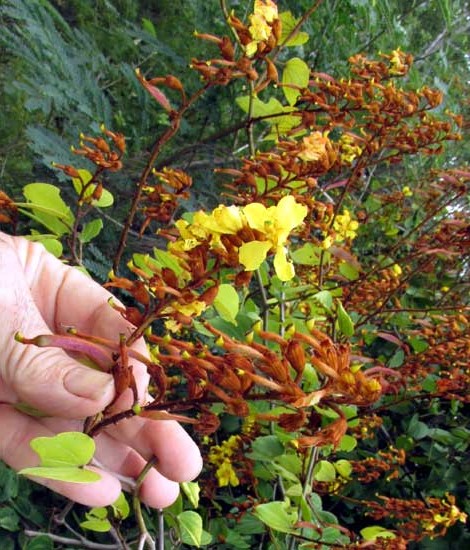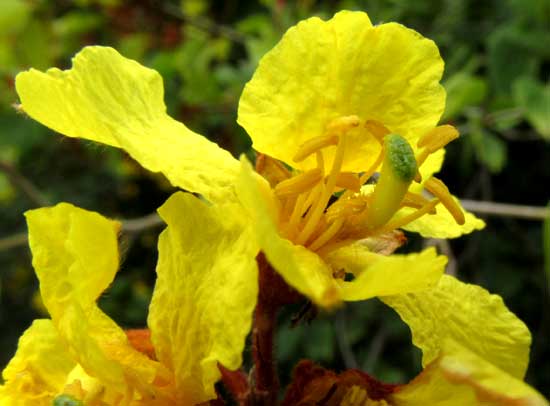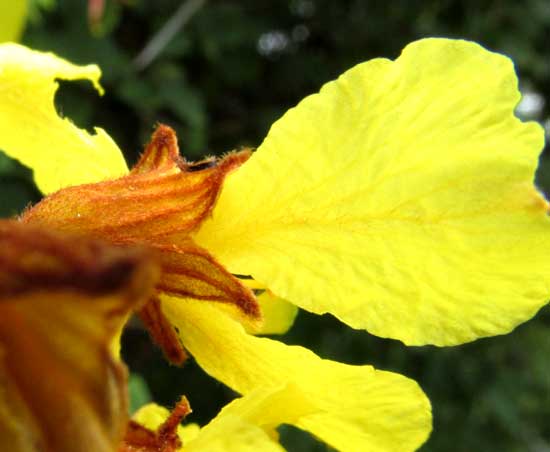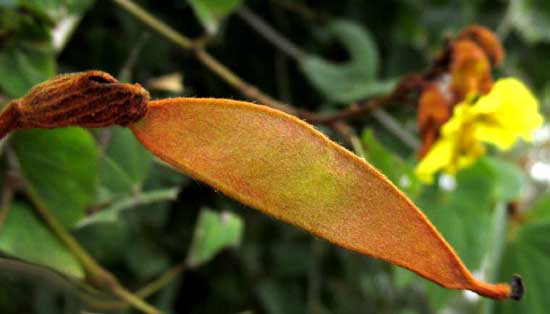Excerpts from Jim Conrad's
Naturalist Newsletter
from the January 15, 2017 Newsletter issued from Rancho Regenesis in the woods ±4kms west of Ek Balam Ruins; elevation ~40m (~130 ft), N20.876°, W88.170°; north-central Yucatán, MÉXICO
A YELLOW-FLOWERED COWFOOT
It's a pleasure to meet any new-to-you species, and take the time to notice what's special about it. Sometimes the fact that you've found something new sneaks up on you, and that's the way it was when a certain small tree began turning up heavily laden with bright, yellow flowers along the Valladolid/Rio Lagartos highway about a kilometer west of the rancho.
For, normally, any small, yellow-flowered tree or bush along the road can be assumed to be a senna, of the Bean Family. Numerous species of the genus Senna occur in the Yucatan, and it can be hard to distinguish one from the other. Knowing that now with such limited Internet time I'd probably be unable to identify any new-to-me Senna species, at first I ignored this yellow-blossomed beauty. However, gradually something about it began seeming unusual, so finally I parked the bike and went over to look closely at one. Below, you can see one of its flowering branches:

The blossoms were a little like senna flowers, but the leaves were nothing like senna leaves. Senna leaves are pinnately compound, but, below, look at a leaf close-up of this tree:

The flowers confirmed the plant's membership of the Bean Family, but the leaves were very unusual for that family. In fact, they're such unusual and distinct leaves that at a glance it was clear that here we had a new-to-us species of the genus Bauhinia, a group of woody shrubs and small trees known as cowfoots. You might enjoy comparing this new cowfoot to other cowfoot species commonly occurring here. There's:
Bauhinia ungulata at www.backyardnature.net/mexnat/bauhinia.htm and
Bauhinia divaricata at www.backyardnature.net/yucatan/bauhinia.htm
About 50 Bauhinia species are listed for Mexico and Central America, with five woody species occurring in the Yucatan Peninsula. Cowfoot species usually display white, pink or red flowers, so this current one with yellow blossoms was easy to identify. But, before naming it, let's look closer at its features. A flower close-up showing weakly bilateral symmetry, like senna flowers, and an unusually thick, curved style with a greenish stigma emerging from among ten stamens of unequal length is shown below:

One of the species' most distinctive features is the calyx, which is densely covered with short, reddish-brown hairs -- they're "ferruginous" -- as seen below:

The trees' legume-type fruits weren't mature yet, but an immature one containing a single seed and also covered with ferruginous hairs is shown below:

Our pretty roadside tree is BAUHENIA HERRERAE*. Despite its escaping my attention until now, the species is described as fairly commonly occurring from southern Mexico south to Nicaragua, with a disjunct population in Peru.
Some literature describes the tree as a creeper bearing tendrils, and a use given for the species is for binding together beams during house construction. On the ones I looked at no tendrils were noticed and the plants weren't creeping. However, they were so solidly wedged into the the roadside's dense scrub that possibly they were being held upright by their neighbors, and often you don't notice something until you know to look for it, and when I was admiring this plant I never suspected that any cowfoot could bear tendrils.